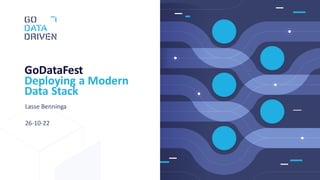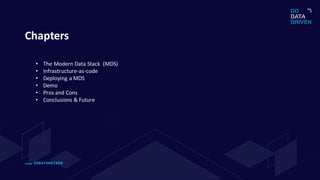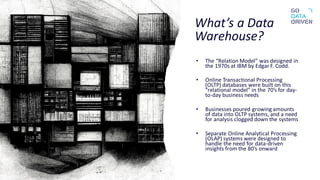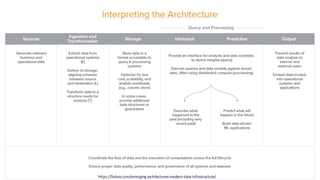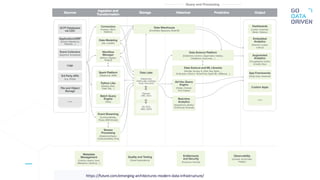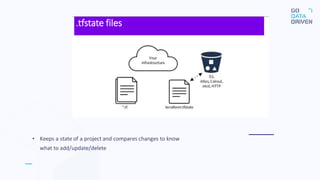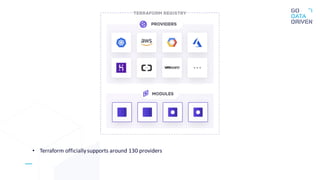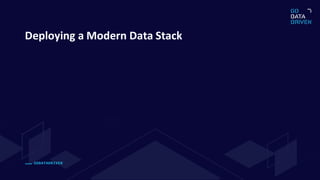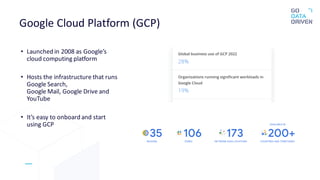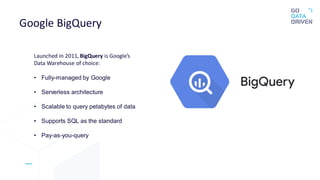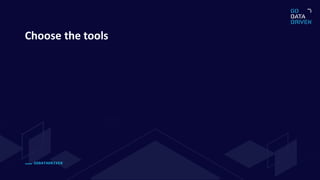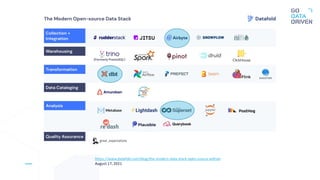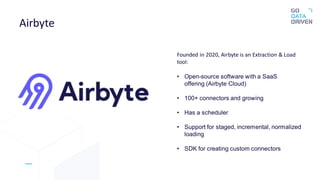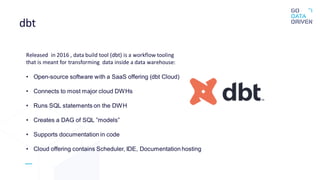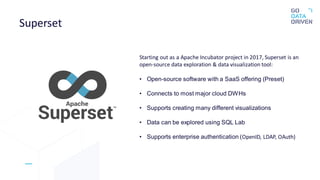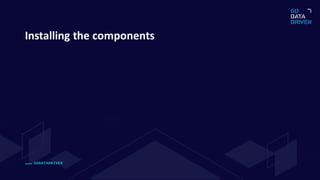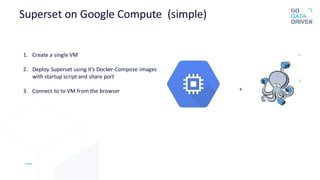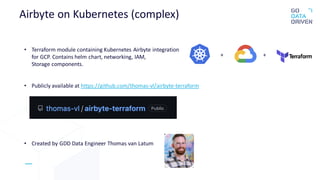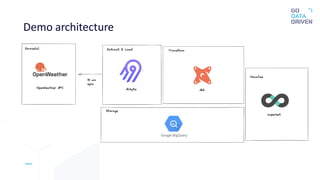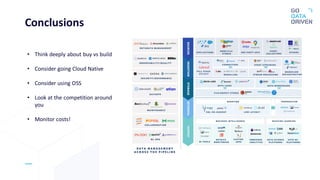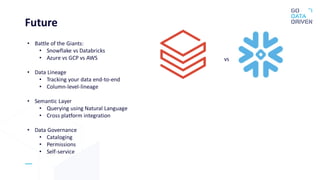Deploying a Modern Data Stack by Lasse Benninga - GoDataFest 2022
- 1. Lasse Benninga 26-10-22 GoDataFest Deploying a Modern Data Stack
- 2. Lasse Benninga • Analytics Engineer @ GDD since 2021 • Studied Informatics in Groningen, background in SE and DE • Love OSS and Data <3 • Live in Utrecht • Enjoy podcasts, running
- 3. GODATADRIVEN Chapters • The Modern Data Stack (MDS) • Infrastructure-as-code • Deploying a MDS • Demo • Pros and Cons • Conclusions & Future
- 4. GODATADRIVEN The Modern Data Stack
- 5. What’s a Data Warehouse? • The “Relation Model” was designed in the 1970s at IBM by Edgar F. Codd. • Online Transactional Processing (OLTP) databases were built on this “relational model” in the 70’s for day- to-day business needs • Businesses poured growing amounts of data into OLTP systems, and a need for analysis clogged down the systems • Separate Online Analytical Processing (OLAP) systems were designed to handle the need for data-driven insights from the 80’s onward
- 9. What's a Modern Data Stack • Cloud Native • Structured and Unstructured data • Pay-as-you-go • SQL-first • Freedom of choice • Managed • Self-hosted
- 11. GODATADRIVEN Terraform • Declarative: describe what you want to achieve instead of how to achieve this • Modular / DRY • Open source • Industry standard • Cloud agnostic
- 13. • Keeps a state of a project and compares changes to know what to add/update/delete
- 14. • Terraform officiallysupports around 130 providers
- 15. GODATADRIVEN Deploying a Modern Data Stack
- 16. Steps for deploying an MDS 1. Pick a cloud. 2. Choose the tools. 3. Deploy the tools. 4. Ingest, Transform, Analyze & Visualize
- 18. Google Cloud Platform (GCP) • Launched in 2008 as Google’s cloud computing platform • Hosts the infrastructure that runs Google Search, Google Mail, Google Drive and YouTube • It’s easy to onboard and start using GCP
- 19. Google BigQuery Launched in 2011,BigQuery is Google’s Data Warehouse of choice: • Fully-managed by Google • Serverless architecture • Scalable to query petabytes of data • Supports SQL as the standard • Pay-as-you-query
- 23. Airbyte Founded in 2020, Airbyte is an Extraction & Load tool: • Open-source software with a SaaS offering (Airbyte Cloud) • 100+ connectors and growing • Has a scheduler • Support for staged, incremental, normalized loading • SDK for creating custom connectors
- 24. dbt Released in 2016 , data build tool (dbt) is a workflow tooling that is meant for transforming data inside a data warehouse: • Open-source software with a SaaS offering (dbt Cloud) • Connects to most major cloud DWHs • Runs SQL statements on the DWH • Creates a DAG of SQL ”models” • Supports documentation in code • Cloud offering contains Scheduler, IDE, Documentation hosting
- 25. Superset Starting out as a Apache Incubator project in 2017, Superset is an open-source data exploration & data visualization tool: • Open-source software with a SaaS offering (Preset) • Connects to most major cloud DWHs • Supports creating many different visualizations • Data can be explored using SQL Lab • Supports enterprise authentication (OpenID, LDAP, OAuth)
- 27. Superset on Google Compute (simple) 1. Create a single VM 2. Deploy Superset using it’s Docker-Compose images with startup script and share port 3. Connect to to VM from the browser +
- 28. Airbyte on Kubernetes (complex) • Terraform module containing Kubernetes Airbyte integration for GCP. Contains helm chart, networking, IAM, Storage components. • Publicly available at https://github.com/thomas-vl/airbyte-terraform • Created by GDD Data Engineer Thomas van Latum + +
- 29. DBT Cloud 1. Create a DBT Cloud account 2. Create Github repository 3. Connect to BigQuery 4. Create ”models” for dataset 5. Create and run period Job in Scheduler
- 30. GODATADRIVEN Demo: Ingest, Transform, Analyze & Visualize
- 33. GODATADRIVEN Pro’s and con’s of the ”DIY” Modern Data Stack
- 34. Pros Cons + Quick to get started + Freedom to pick components + Pay-as-you-go cost model + Stand of the shoulders of OSS - Can become very complex to maintain - Cost model can be deceiving - Dependent on OSS community - Dangers of free architecture
- 36. Conclusions • Think deeply about buy vs build • Consider going Cloud Native • Consider using OSS • Look at the competition around you • Monitor costs!
- 37. Future • Battle of the Giants: • Snowflake vs Databricks • Azure vs GCP vs AWS • Data Lineage • Tracking your data end-to-end • Column-level-lineage • Semantic Layer • Querying using Natural Language • Cross platform integration • Data Governance • Cataloging • Permissions • Self-service vs
- 38. Links • https://www.moderndatastack.xyz/ • https://future.com/emerging-architectures-modern-data-infrastructure/ • https://www.datafold.com/blog/the-modern-data-stack-open-source-edition
- 39. GDD Solutions Let us deploy a MDS for you and land your firstanalytics usecase! Check out https://godatadriven.com/what-we-do/solutions/

